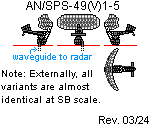AN/SPS-49
History
The AN/SPS-49 was conceived as part of the same frequency diversity program that produced the AN/SPS-40. The radar is an 2D air search radar using the L band frequency. The prototype was tested on board the destroyer Gyatt between July 1964 and June 1965. The radar figured in many USN warship designs of the late 1960's but was at that point never bought in numbers. It was revived in modified form in 1970 and then evaluated on board the missile cruiser USS Dale in 1976. It was then bought in quantity to equip the FFG-7 class. after that, the radar was used together with the AN/SPS-48E in the NTU program to upgrade the abilities of standard missile equipped ships. Finally, it was fitted to the AEGIS System on board the Ticonderoga class cruisers.
The antenna is stabilised to compensate for the ships pitch and rule to a maximum of 23.5 degrees.
In the 1990's development of a planar array SPS-49 was initiated. This would result in the SPS-49 gaining some 3D abilities while retaining it's long range. The antenna was tested in the 1990's on one of the Ticonderoga class cruisers but was not procured.
The radar is still in use on many ships in and outside the USN.
Used on
- Nimitz-class aircraft carrier
- Kitty Hawk-class aircraft carrier
- Iowa-class battleship
- Ticonderoga-class cruiser
- Virginia-class cruiser
- Leahy-class cruiser
- USS Hayler
- Oliver Hazard Perry-class frigate
- Alpino-class frigate
- Bergamini-class frigate
- Anzac class frigate
- Halifax class frigate
- Te Kaha class frigate
- Chungmugong Yi Sun-sin class destroyer (KDX-I)
Affiliated systems
Part description
Both sides, a front view and top are drawn of the 'regular' SPS-49 radar antenna. A side and a front view are drawn of the planar SPS-49 antenna. The drawing is based on limited references so might be inaccurate.
See also
https://www.radartutorial.eu/19.kartei/07.naval/karte002.en.html

